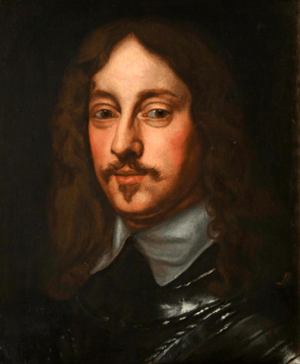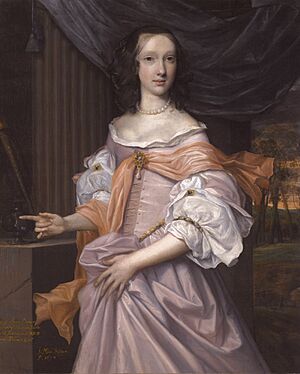Montagu Bertie, 2nd Earl of Lindsey facts for kids
Quick facts for kids Montagu Bertie |
|
|---|---|
| Earl of Lindsey | |
 |
|
| The Earl of Lindsey. | |
| Spouse(s) | Martha Ramsay (née Cockayne), Dowager Countess of Holderness Bridget Wray |
| Issue | |
| Robert Bertie, 3rd Earl of Lindsey Hon. Peregrine Bertie Hon. Richard Bertie Hon. Vere Bertie Hon. Charles Bertie Elizabeth, Viscountess Campden Bridget, Duchess of Leeds Lady Catherine Dormer |
|
| Noble family | Bertie |
| Father | Robert Bertie, 1st Earl of Lindsey |
| Mother | Elizabeth Montagu |
| Born | 1608 Grimsthorpe, Lincolnshire, England |
| Died | 25 July 1666 (aged 57–58) Campden House, Kensington, London, England |
| Burial | Grimsthorpe |
Montagu Bertie, the 2nd Earl of Lindsey, was an important English soldier and politician. Born in 1608, he played a key role during a very turbulent time in English history, especially during the English Civil War. He was a strong supporter of King Charles I.
Contents
Early Life and Beginnings
Montagu Bertie was born at Grimsthorpe Castle in Lincolnshire. He was the oldest son of Robert Bertie, who was the 1st Earl of Lindsey. His mother was Elizabeth Montagu.
He briefly studied at Sidney Sussex College, Cambridge in 1623. After his studies, he became a Member of Parliament (MP). An MP is a person elected to represent a group of people in the country's parliament. Montagu represented Lincolnshire in 1624 and Stamford from 1625 to 1626. When his father became an Earl, Montagu started using the title Lord Willoughby de Eresby.
During his younger years, Montagu also served as a Captain in a cavalry troop. Cavalry are soldiers who fight on horseback. He served in the Low Countries, which are parts of modern-day Belgium and the Netherlands. He became a favorite of King Charles I. The King gave him important roles, like being a Gentleman of the Privy Chamber. This was a trusted position close to the King.
Preparing for Conflict
In 1639, Lord Willoughby helped raise a special army unit called The King's Life Guard of Foot. This unit had four companies of soldiers. They were formed to fight in the Bishops' Wars, which were conflicts between England and Scotland. He was given a Captaincy in this new regiment.
The next year, he received more important positions. In November 1640, he was called to join the House of Lords. This is the upper house of the Parliament of the United Kingdom. He joined as Baron Willoughby de Eresby. In 1641, Lord Willoughby traveled to Scotland with some friends. Their trip was even written about in a poem!
Fighting in the English Civil War
Both Lord Willoughby and his father strongly supported King Charles I. They raised a cavalry regiment in Lincolnshire to fight for the King. The English Civil War was a series of wars between Parliamentarians (often called "Roundheads") and Royalists (often called "Cavaliers") over how England should be governed.
Key Battles and Leadership
Lord Willoughby commanded the Life Guards at the Battle of Edgehill. This was one of the first major battles of the war. Sadly, his father was badly wounded there and later died. After his father's death, Montagu became the new Earl of Lindsey and also the Lord Great Chamberlain.
He was captured by the Parliamentarians and held in Warwick Castle. While imprisoned, he wrote a strong statement explaining why he was loyal to the King. He was released in July 1643 as part of a prisoner exchange. He then rejoined the King in Oxford. He became a Privy Counsellor in December, which meant he advised the King.
As a high-ranking officer, he fought in many important battles. He was a colonel of the King's Life Guards of Foot. Later, he became a lieutenant-general, leading all the foot soldiers. He fought at the First Battle of Newbury, Cropredy Bridge, Lostwithiel, and the Second Battle of Newbury. He was wounded at the Battle of Naseby, another major battle.
Efforts for Peace
Even while fighting, Lindsey often tried to make peace with Parliament. He frequently acted as a commissioner, trying to negotiate a settlement. He always pushed for the King and Parliament to find a way to reconcile. The King also gave Lindsey more honors. He served as a Gentleman of the Bedchamber from 1643 to 1649. This was another very close and trusted position to the King.
Lindsey was present when Oxford surrendered in June 1646. He stayed with the King in 1647. He also served as a commissioner for the Treaty of Newport in 1648. This was another attempt to reach a peace agreement. He even stayed with the King during his trial. After the King was executed, Lindsey accompanied his body to its burial place at Windsor.
His loyalty to the King came at a high cost. He had to pay a large sum of money to keep his family's estates. He finally finished paying this off in 1651.
Life After the War
After King Charles I was executed, Lindsey decided to live a quiet life. Even though the new government watched him closely, he did not get involved in any plots against them.
The Restoration and Later Years
When the monarchy was brought back (this is called the Restoration), Lindsey was given back his important roles. He rejoined the Privy Council. He was also re-appointed as Lord Great Chamberlain. He became the Lord Lieutenant of Lincolnshire, which meant he was the King's main representative in that county.
On April 1, 1661, he was made a Knight of the Garter. This is a very high honor in England. He also played a special role as Lord Great Chamberlain at the coronation of King Charles II on April 23, 1661. In 1662, he was named one of the commissioners for the office of Earl Marshal.
Montagu Bertie, 2nd Earl of Lindsey, passed away in 1666. He died at Campden House in Kensington, which was the home of his son-in-law. He was buried back in Grimsthorpe.
Family Life
Montagu Bertie was married twice and had several children.
His first marriage was on April 18, 1627, to Martha Ramsay. She was the Dowager Countess of Holderness. They were married in the City of London. Together, they had eight children:
- Robert Bertie, 3rd Earl of Lindsey (1630–1701)
- Hon. Peregrine Bertie (around 1634–1701)
- Hon. Richard Bertie (around 1635 – 1685/6)
- Hon. Vere Bertie (died 1680)
- Hon. Charles Bertie (around 1640–1711)
- Lady Elizabeth Bertie (died 1683), who married the 3rd Viscount Campden.
- Lady Bridget Bertie (1629 – 1704), who married the 1st Duke of Leeds.
- Lady Catherine Bertie, who married Robert Dormer.
Martha passed away in July 1641. Montagu then married Bridget Wray sometime between 1646 and 1653. She was the Baroness Norris. From this second marriage, they had four more children:
- James Bertie, 1st Earl of Abingdon (1653–1699)
- Hon. Edward Bertie
- Hon. Henry Bertie (around 1656–1734)
- Lady Mary Bertie (1655–1709), who married the 2nd Earl of Carnarvon.


